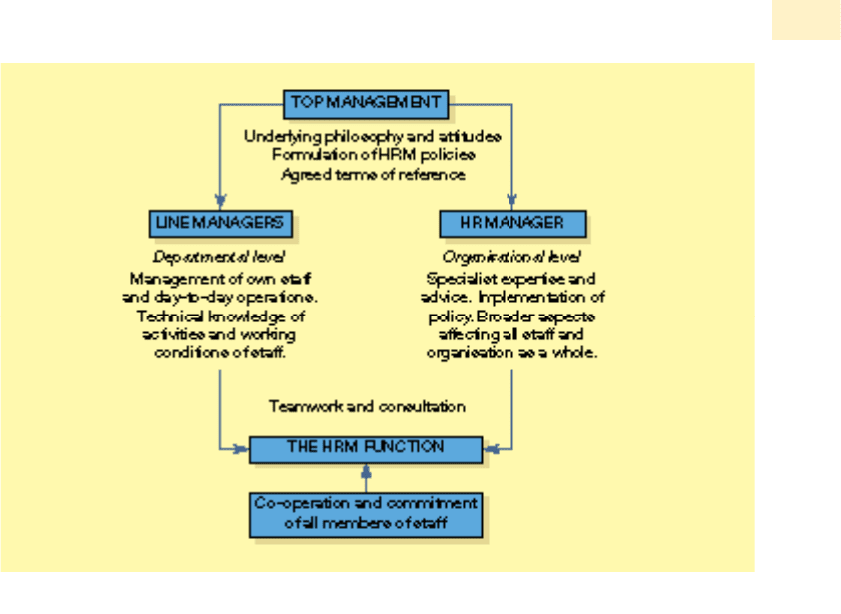Mullins L.J. Management and organisational behaviour, Seventh edition
Подождите немного. Документ загружается.


CHAPTER 18 JOB SATISFACTION AND WORK PERFORMANCE
745
51. ‘Effective Organisations; The People Factor’, Advisory
Booklet, ACAS, November 2001.
52.
Cooper, C. and Worrall, L. The Quality of Working Life,
1999 Survey of Managers’ Changing Experiences, The
Institute of Management and UMIST. For a summary,
see: Professional Manager, January 2000 and March 2001.
53. Rigby, R. ‘Promiscuous Managers’, Management Today,
May 2000, pp. 60–1.
54. Oliver, J. ‘Losing Control’, Management Today, June
1998, pp. 32–38.
55. Rice, M. ‘Greater Expectations’, Management Today,
June 2001, pp. 76–85.
56. ‘Work-Life Balance: The Business Case’, Department of
Trade and Industry, September 2001, p. 3.
57. Rice, M. ‘Balancing Acts’, Management Today, September
2002, pp. 52–9.
58.
Summers, J. and Nowicki, M. ‘Achievement and Balance:
What do Managers Really Want?’, Healthcare Financial
Management, vol. 56, no. 3, March 2003, pp. 80–4.
59. Reeves, R. ‘The Joy of Work’, Management Today, May
2001, pp. 60–3.
60. Armitage, K. ‘Can We Really Achieve a Life/Work
Balance?’ The British Journal of Administrative
Management, July/August 2001, pp. 14–15.
61.
See, for example: Coupar, W. ‘Employee Involvement
and Performance: UK Experience’, European Participation
Monitor, no. 9, 1994, pp. 45–50.
62. ‘Working Together: the ACAS standard’, ACAS,
January 2003
63. Heller, F. ‘Is Participation Really Working?’ QWL News
and Abstracts, ACAS, No. 138, Spring 1999, pp. 6–11.
64. Wolfson, Sir Brian ‘Train Retain and Motivate staff’,
Management Today, March 1998, p. 5.
65.
Jamison, C. ‘Top 10 Myths of Customer Service’, The
British Journal of Administrative Management, July/August
1999, p. 20.
66. Pickard, J. ‘The Real Meaning of Empowerment’,
Personnel Management, vol. 25, no. 11, November 1993,
pp. 28–33.
67.
Wilkinson, A. ‘Empowerment: Issues and Debates’,
QWL News and Abstracts, ACAS, no. 137, Winter 1999,
p. 5.
68. Cordery, J. L., Mueller, W. S. and Smith, L. M.
‘Attitundinal and Behavioral Effects of Autononmous
Group Working’, Academy of Management Journal, June
1991, pp. 464–76.
69. See, for example: Robbins, S. P. Organizational
Behaviour, Eighth edition, Prentice-Hall (1998).
70. Wilson, J. ‘Building Teams – with Attitude’,
Professional Manager, September 1998, pp. 12–13.
71. Torrington D, Hall L and Taylor S, Human Resource
Management, Fifth edition, Financial Times Prentice
Hall, (2002), p. 316
72. Waterman, R. The Frontiers of Excellence, Nicholas
Brealey (1994).
73. Teamwork: Success Through People, Advisory Booklet,
ACAS, April 2003, p. 34.
74. The Survey of Long Term Employment Strategies, The
Institute of Management and Manpower plc,
September 1996.
75.
Flexibility and Fairness, Institute of Management and
TUC, September 1996 reported in ‘Flexible Employment’s
Here to Stay’, Professional Manager, November 1996,
p. 31
.
76. Rawcliffe, S. ‘Flexible Rewards’, Chartered Secretary,
November 1997, p. 27.
77. ‘Work-Life Balance: The Business Case’, Department of
Trade and Industry, September 2001.
78. ‘Flexible Working – Case studies’, Equal Opportunities
Commission, www.eoc.org.uk, 24 June 2003.
79. See, for example: Barnes, P. ‘Teleworking – The Cat’s
Whiskers?’, Chartered Secretary, May 1997, pp. 20–1.
80. Philpott, S. ‘Making the Right Connections?’ The
British Journal of Administrative Management,
July/August 1999, pp. 8–10.
81. ‘The Workplace Survey’, Chartered Management
Institute, March 2003.
82. Russell, S. Quality Circles in Perspective, ACAS Work
Research Unit, Occasional Paper, no. 24 (February
1983).
83. Meyer, G. W. and Scott, R. G. ‘Quality Circles: Panacea
or Pandora’s Box’, Organizational Dynamics, Spring
1985, pp. 34–50.
84. See, for example: Hill, S. ‘Why Quality Circles Failed
But Total Quality Management Might Succeed’, British
Journal of Industrial Relations, vol. 29, no. 4, 1991,
pp. 541–68.
85. See, for example: Cartwright, J. Cultural Transformation,
Financial Times Prentice Hall (1999).
86. Scarpello, V. and Vandenberg, R. J. ‘The Satisfaction
with My Supervisor Scale: Its Utility for Research and
Practical Applications’, Journal of Management, vol. 13,
no. 3, 1987, pp. 447–66.
87. Bassett, G. ‘The Case Against Job Satisfaction’, Business
Horizons, vol. 37, no. 3, May–June 1994, pp. 61–8.
88. See, for example: Green, J. R. ‘Just Whistle While You
Work’, Chartered Secretary, March 1997, pp. 20–1.
89. Crow, S. M. and Hartman, S. J. ‘Can’t Get No
Satisfaction’, Leadership & Organization Development
Journal, vol. 16, no. 4, 1995, p. 34.
90. See, for example: Torrington, D., Hall, L. and Taylor, S.
Human Resource Management, Fifth edition, Financial
Times Prentice Hall (2002).
91.
Staw, B. M. ‘Organizational Psychology and the Pursuit
of the Happy/Productive Worker’, California Management
Review, vol. 28, no. 4, Summer 1986, pp. 40–53.
92. Bassett, G. ‘The Case Against Job Satisfaction’, Business
Horizons, vol. 7, no. 3, May–June 1994, p. 67.
93. Heller, F. ‘Is Participation Really Working?’ QWL News
and Abstracts, ACAS, No. 138, Spring 1999, pp. 6–11.
FT
Use the Financial Times to enhance your understanding of the context and practice of management and
organisational behaviour. Refer to articles 5, 10, 13, 19, 20 and 26 in the BUSINESS PRESS section at
the end of the book for relevant reports on the issues explored in this chapter.

The key fact about a policy of good human
relations at work is that it is not primarily
concerned with the nature of the work which
the employee does but with the state of
mind, the spirit in which he or she does it. A
policy of good human relations at work is
not about jobs, it is about people.
(Lord) Marcus Sieff
Management The Marks & Spencer Way, Fontana (1991)
HUMAN RESOURCE
MANAGEMENT
The efficiency and performance of staff, and
their commitment to the objectives of the
organisation, are fostered by good human
relationships at work. This demands that
proper attention be given to human resource
management and harmonious employment
relations. The manager needs to understand
the importance of good managerial practices
and how to make the best use of people. The
promotion of good human relations is an
integral part of the process of management and
improved organisational performance.
LEARNING OUTCOMES
After completing this chapter you should be able to:
explain the nature of human resource management
(HRM), and contrast this with personnel management;
analyse HRM policies, activities and functions;
justify HRM as a shared responsibility and explain the
organisation of the HRM function;
examine the importance and benefits of training and
development, and the effective management of training;
explore the system of performance management,
methods of appraisal and potential problem areas;
explain the nature of employment relations, and
reasons for attention to legal and behavioural dimensions;
review the importance of the HRM function for
individual and organisational performance and
effectiveness.
19
Photo: Silvestre Machado/Getty Images

However the activities of management are identified, and whatever the nature of
organisational processes, an essential part of the process of management is that proper
attention be given to the efficient use of resources, in particular human resources. The
human element plays a major part in the overall success of the organisation. There
must be effective management of human resources.
The significance of human resources and people as the most important asset of any
organisation is emphasised by Gratton. As the basis of her ‘Living Strategy’, Gratton
puts forward four basic propositions:
1 there are fundamental differences between people as an asset and the traditional
assets of finance or technology;
2 an understanding of these fundamental differences creates a whole new way of
thinking and working in organisations, a shift in mind-set;
3 business strategies can only be realised through people;
4 creating a strategic approach to people necessitates a strong dialogue across the
organisation.
1
The personnel management/HRM debate
You will be aware that in recent years there has been a noticeable popularity in the use
of the term ‘human resource management’ (HRM) to replace the term ‘personnel manage-
ment’. The personnel management/HRM debate is now a well-trodden path and much
has been written about the subject. Discussion generally centres on the extent to
which either: HRM is a new and distinctive philosophy with a paradigm shift towards a
more strategic approach to people management; or simply ‘new wine in old bottles’
and in reality no more than a different term for what good personnel managers have
always been doing.
2
There seems little to be gained by proliferating this debate except perhaps in sum-
mary to suggest that it is difficult to escape the thought that the increasing use of the
term HRM has been associated with those engaged in personnel work seeking to
enhance their status and influence. Not, however, that there is anything necessarily to
criticise about this. The essential point is that it does not follow that HRM however it is
described will, per se, result in a higher level of job satisfaction or organisational per-
formance than would be achieved with a traditional personnel management approach.
It is, however, recognised that developments in communications information technol-
ogy, new forms of work organisation and structure, and increasing attention to
empowerment, flexible working arrangements and new psychological contracts
(discussed in Chapter 2) certainly provide a challenge to traditional personnel manage-
ment (or HRM) theories and practices.
Definitions of HRM
HRM is often defined in very general and broad terms. For example, according to Fisher
et al. ‘Human resource management (HRM) involves all management decisions and
practices that directly affect or influence the people, or human resources, who work
for the organization.’
3
The Chartered Institute of Personnel and Development (CIPD) is a professional body
for all those concerned with the management and development of people. The
Institute provides the following definition: ‘The design, implementation and mainte-
nance of strategies to manage people for optimum business performance including the
development of policies and processes to support these strategies.’
4
CHAPTER 19 HUMAN RESOURCE MANAGEMENT
THE NATURE OF HUMAN RESOURCE MANAGEMENT (HRM)
747

Interestingly, apart from a change in title, a more detailed definition given by
Torrington et al. in 1995 remains unchanged today.
Personnel management is a series of activities which: first enables working people and the
organisation which uses their skills to agree about the objectives and nature of their working
relationship, and secondly, ensures that the agreement is fulfilled.
With the exception of a shift in title from ‘personnel management’ to ‘human resource manage-
ment’ this remains our philosophy.
5
A strategic approach
It seems reasonable to conclude that there is no clear distinction between personnel
management and human resource management. However, the increasing emphasis on
effective employee relations, and the importance of securing the involvement and
commitment of staff to the aims of the organisation may, at least in part, be argued as
justification for the change in title. Crainer, for example, refers to the change from per-
sonnel management to human resource management.
With hierarchies decreasing and the growing emphasis on becoming leaner and fitter, the onus
is increasingly on corporations extracting the best possible performance from all employees. In
(best) practice this means recruiting well-qualified and highly skilled people and developing the
skills of everyone in the organization. With increased acceptance of its importance, personnel
management has become human resource management. The emerging role of human resource
management is radically different from that of the past when it dealt with the bureaucracy of
employing people and little else. From being a caring role, human resources is being realigned
as a strategic role, focused on the business needs and strategic plans of the corporation.
6
According to Delany, organisations that get the people things right are the organisa-
tions likely to be around in the future.
Some organisations regard human resources as a purely transactional item: recruitment,
salaries, laying off. Others try to go beyond that and try to develop a meaningful people strategy
but fail. But the successful organisations keep the people issues at the forefront of their thinking
and at the core of their decision making and planning … The human resource element has to be a
vital part of the planning process – just as vital as the financial forecasts. Companies need a
people vision which will support the vision for a business.
7
748
PART 7 MANAGEMENT OF HUMAN RESOURCES
Competencies-based human resources management
Since the late 90s the business environment hasradically changed. Nowadays companies are
under great pressure to find new strategies to cope with a rapidly changing business environ-
ment. When the rate and quality of change exceed a certain threshold, the need for talented
people to run the business will become a more critical success factor. Organizations have
come to realize that they must invest in their human resources to release true value. In all
services, the competitive edge will come as much from people as from the product. As trends
in the business environment reshape organizational life, Human Resource practitioners must
respond with new strategies, competencies and practices.
The strategic use of human resources will help managers to contribute to the release of
true value by the optimum use of people’s competencies. A strategic HR approach requires
that the needs and talents of employees become matched with the organization’s goals.
People’s competencies should become the building blocks of successful organizations in
the future. To sustain and develop the required people’s competencies for future success,
an organization needs to have a system with which it can discriminate good to superior
from poor to average performance by means of critical observance or measurement.
Because, as you know: competency refers to good/superior performance.

Whatever the debate on comparative meanings or functions, the term ‘human
resource management’ despite its (present) popularity has, in the view of the author,
overtones of a cold, impersonal approach. Human resources are clearly the most
important asset of any organisation and a resource which needs to be managed, but it
is important to remind ourselves that unlike physical resources, people are not owned
by the organisation. People are individuals who bring their own perceptions, feelings
and attitudes towards the organisation, systems and styles of management, their duties
and responsibilities, and the conditions under which they are working. It is pleasing,
therefore, to see what appears to be the increasing use of the terminology ‘people man-
agement’ or the ‘management of people’.
Whatever the nature of the work organisation, a manager achieves results through the
performance of other people. Recognition of the needs and wants of staff and of the
nature of their grievances is a positive step in motivating them to perform well. The effi-
ciency of staff, their commitment to the aims of the organisation, and the skills and
attitudes they bring to bear on the quality of service offered are fostered by good human
relationships and effective HRM policy and practice. The effective management of people
is influenced by the philosophy of top management and the attitudes which they bring
to bear on relationships with staff, and the problems which affect them. HRM policies
should emanate from the top of the organisation. They should be defined clearly and
communicated through managers and supervisors to staff at all levels. An example is the
need for a clearly stated policy on the use of ICT resources (including email and Internet)
which is clear about prohibited activities and consequences of failure to adhere to the
policy such as disciplinary action and potential sanctions.
Underlying philosophies
The formulation of HRM policies, and the implementation of personnel practices and
procedures, should be based on underlying philosophies of managerial behaviour and
employee relationships. Such philosophies should embrace:
CHAPTER 19 HUMAN RESOURCE MANAGEMENT
749
Organizations in the future will be different from today. Traditional hierarchical relations
will be replaced by networks of empowered workgroups. Information will be at everyone’s
fingertips. Careers will become a sequence of assignments rather than a logical sequence
of different jobs representing a climb to the top. In this context, employees will work more
in teams, where they are not tied to a management level by traditional hierarchical lines.
Because of the complexity of work and the need for autonomy, teams need a certain
amount of freedom to accomplish their task. Performance of teams is measured on the
accomplishment of the mission to contribute to the business future success.
To benefit from the opportunities this new type of organization provides, a new type of
human resource management is needed, which is based on a clear notion of required com-
petencies for future success in new individual and team-roles. This will require a much
sharper image of the real strengths and weaknesses of people and their possible contribu-
tion to the organization and to teamwork. If the effort to transform human resources
practices is done well, HR practitioners can play a strategic role as managers that can lever-
age human capital and expert knowledge for competitive advantages. If HR practitioners
cannot meet this challenge, they will play a more limited role in the future organization.
Marijke Dieleman
8
HRM POLICIES, ACTIVITIES AND FUNCTIONS

■ the recognition of people’s needs and expectations at work;
■ respect for the individual;
■ justice in treatment and equitable reward systems;
■ stability of employment;
■ good working environment and conditions of service;
■ opportunities for personal development and career progression;
■ democratic functioning of the organisation; and
■ full observance of all laws and codes of conduct relating to employment.
In overall terms, HRM policies can be seen to embrace:
■ designing an effective organisation structure;
■ staffing the structure with suitable people;
■ defining work roles and relationships; and
■ securing optimum working arrangements.
The objective is to develop and maintain a level of morale and human relationships
which evoke willing and full co-operation of all persons in the organisation in order to
attain optimum operational performance. This is the total concept of the personnel
function. It is important to remember, however, that no matter how genuine and well
intended are HRM policies, they must also be practically and effectively implemented.
According to Lorange we will see many changes in the behavioural side of human
resource processes. Instead of the typical hierarchical structure, executives will now
largely be allowed to organise themselves in teams with a focus on realigning people to
work together to find opportunities and learn how to exploit them. The strategic human
resource process will therefore be drawn to support a mostly self-organised, virtual team
process, attempting to guide people to find their productive places in such teams.
9
The range and scope of HRM activities are very wide and may be considered within the
framework of the following broad headings:
■ human resource planning;
■ recruitment, selection and induction;
■ salary and wage administration including related reward systems;
■ organisational design and patterns of work;
■ education, training and development;
■ employee relations; and
■ employee services, welfare, health and safety.
Inherent in these activities is the need to give proper regard and attention to employ-
ment legislation and other legal requirements. A system of human resource planning
will provide the link between objectives and organisation structure, and clarification of
personnel policies. It provides a framework within which personnel activities are
planned and implemented. (Human resource planning is discussed in Chapter 20.)
Ethical dimensions of HRM
In Chapter 5 we discussed the importance of social responsibilities of organisations and
the complex nature of business ethics. Any debate about the role of HRM gives rise to
considerations of ethical values and judgements. For example, Winstanley et al. put for-
ward four alternative ethical frameworks for judging personnel practices:
■ basic right – to be consulted on all matters affecting the individual at work;
■ organisational justice – fairness in treatment, equality of opportunity and equity;
■ universalism – acknowledging respect for the individual; and
■ community of purpose – recognition of how organisational decision-making affects
different groups or stakeholders.
10
750
PART 7 MANAGEMENT OF HUMAN RESOURCES
Range of HRM
activities

Winstanley and Woodall also draw attention to the ethical dimension of HRM.
They suggest that ethical frameworks and principles can be applied through action on
three levels:
■ academic debate – including incorporation of ethical aspects into HRM and organi-
sational behaviour curricula at both undergraduate and postgraduate level;
■ academic research – including evidence-based research to identify the full range of
ethical concerns and practices, and to explore relationships between humanism and
employee performance; and
■ professional HR practice – including a role for the CIPD in promoting ethical
debate, and for HR professionals to become a champion, architect and steward of
ethical management of people.
11
Smaller organisations may not justify a specialist human resource (or personnel) man-
ager or a separate department. But it is still necessary to have an effective HRM
function, whether it is the responsibility of the owner or of a manager, or an adminis-
trative assistant. Even in the smallest organisations, or in organisations where a
specialist department has not been established, there will be a need to recruit staff, to
train them, to motivate and reward them, and to comply with the law relating to
employment. Personnel work must still be carried out even if an organisation is too
small to justify a separate department or chooses not to establish one.
Areas of specialisation
In the larger concerns, where more time is taken up with problems of organisation and
the management of people, there is greater need for a specialist member of staff to
whom are delegated full-time responsibilities for advising top management on human
resource matters and for the development and implementation of clearly defined poli-
cies which permit consistent HRM practices. For example, high staffing costs together
with increasing employment legislation suggest that greater attention must be given to
the process of recruitment and selection. Other examples include:
■ pressures for the exercise of a greater social responsibility towards staff;
■ the general movement towards employee involvement and empowerment;
■ proposals from the European Union and national government in terms of employ-
ment legislation;
■ government involvement in formal or informal incomes policies;
■ developments in the applications of behavioural science;
■ social and government pressure to improve the work/life balance;
■ the role of the employment tribunals, and the Advisory, Conciliation and
Arbitration Service (ACAS) and other statutory bodies;
■ the role of trade unions, and their officials and elected representatives; and
■ the increasing internationalisation of labour.
These factors all combine to suggest that personnel activities and employee relations
are areas of increasing specialisation. Tyson, for example, suggests that the specialist
personnel function emerged within the potential conflicts between capital and labour
and is based on the need to mitigate the worst aspects of domination within the
employment relationship.
12
There continues to be much debate about the value of the
HR function to the bottom line. This has inevitably contributed to the changing nature
of the personnel function and increasing specialisation of the role.
13
CHAPTER 19 HUMAN RESOURCE MANAGEMENT
751
ORGANISATION OF THE HRM FUNCTION

Even where personnel work is established as a separate, specialist function, it is not easy
to define closely the activities of the HRM department. The range of responsibilities
varies from one organisation to another, as do the title and status of the head of the
department and position in the management structure. In the larger organisations per-
sonnel activities might be divided between two or more specialists, so that it would be
possible to have, for example, a human resources manager, a personnel officer, training
officer and employee relations advisor. Whatever the range of responsibilities, the man-
ager operates by consent, by delegated authority. How much consent is dependent upon
the attitudes of top management, the role which they see the personnel specialist(s) per-
forming and formal organisational relationships with ‘line’ managers.
Line managers are departmental or unit managers with responsibility for the ‘produc-
tion’ process – for the operational functions directly related to the purpose and aims of
the organisation. They form a hierarchical level in the chain of command throughout
the organisation structure (discussed in Chapter 15). Line managers report directly to
higher management for the activities within their own department and for its opera-
tional efficiency. There is unity of command, a clear line of authority and a direct
boss–subordinate relationship between line managers and their staff. Line managers are
responsible for the management of their own staff. However, although line managers
are specialists in their own area of work, they are not necessarily specialists in human
resource management. Just as line managers turn to specialists on legal and accounting
matters and the use of technology, so they will need help, guidance and specialist
advice on personnel activities.
The HRM function is part of the generality of management and part of the responsibil-
ity of all managers and supervisors. The HR manager, as a separate entity, operates in
terms of a ‘functional’ relationship, that is as a specialist advisor on matters and on the
implementation of policies through all departments of the organisation. It is the job of
the HR manager to provide specialist knowledge and services for line managers, and to
support them in the performance of their jobs.
In all other respects the HR manager’s relationship with other managers, supervisors
and staff is indirect: it is an advisory relationship. It is the line managers who have
authority and control over staff in their departments, and who have the immediate
responsibility for personnel activities, although there will be times when they need
specialist help and advice. If the HRM function is to be effective there has to be
good teamwork, and co-operation and consultation between line managers and
the HR manager.
This is made easier when top management take an active part in fostering goodwill
and harmonious working relationships among departments. It is important to have
clear role relationships and to attempt to avoid difficulties with role incongruence or
role conflict (recall the discussion in Chapter 13). Top management should agree clear
terms of reference for the HR manager within a framework of sound personnel policies.
The effective management of people involves a partnership between managers and HR
specialists. Within this framework the HRM function can be seen as operating at two
levels: the organisational level and the departmental level. (See Figure 19.1.)
At the organisational level the detailed involvement of the work activities of several
departments, available time, and the need for specialisation suggest that the HR man-
ager has a prominent role to play and is the main executor of personnel policies but
acting in consultation with, and taking advice from, line managers. On this basis the
752
PART 7 MANAGEMENT OF HUMAN RESOURCES
The human
resources
manager
Line managers
HRM: A SHARED RESPONSIBILITY
The
organisational
level

HR manager would be concerned mainly with broader aspects of policy and procedures
which affect the organisation as a whole or staff generally. This could include such
activities as: human resource planning; job analysis and procedures for recruitment
and selection; induction and training; problems of high labour turnover; consultations
with trade unions or staff representatives; employee development; compliance with the
law relating to employment; maintaining records and statistics; and liaison with out-
side bodies such as ACAS, employers’ organisations, government agencies, Criminal
Records Bureau, training organisations and professional associations.
At the departmental or unit level the line managers might assume a prominent role for
day-to-day personnel matters, with the HR manager as advisor, and if necessary as arbi-
trator. Line managers would be more concerned, at least in the first instance, with the
operational aspects of HR activities within their own departments. For example: the
organisation of work and allocation of duties; minor disciplinary matters; standards of
work performance; safety; on-the-job training; communication of information; and
grievances from staff. Line managers have the right and the duty to be concerned with
the effective operation of their own department, including the well-being of their staff.
In this respect it could be said that all line managers are their own human
resource managers. Line managers are on hand to observe directly the performance of
their staff. They will actually see, and be directly affected by, for example, lateness of
staff, unsatisfactory work, insufficient training, low morale, staff unrest, or poor plan-
ning of work duties and responsibilities. As an element function, HRM is an integral
part of any managerial activity. It is the line managers who have the immediate
responsibility for effective personnel activities.
Whatever the respective roles of the HR manager and line managers, the HRM func-
tion can only be effective if it is based and implemented on sound policies and
procedures. It also requires the co-operation and commitment of all members of staff,
whatever their duties or positions within the organisation. The HRM function cannot
CHAPTER 19 HUMAN RESOURCE MANAGEMENT
753
Figure 19.1 the HRM function – a shared responsibility
The department
level

754
PART 7 MANAGEMENT OF HUMAN RESOURCES
be housed within one discrete department or as the sole responsibility of selected mem-
bers of staff. It permeates all levels of the organisation and all phases of its operations.
The extent to which authority and responsibility for the personnel function is
devolved to line managers is a decision for top management, and is likely to be influ-
enced by the nature, culture, structure and characteristic features of the particular
industry or organisation. For example, Rocco Forte has emphasised the importance of a
caring and efficient personnel function to assist line managers in what is one of their
primary responsibilities. The nature of the hospitality business, with many separate
units of differing size, location and mix of skills, means of necessity the personnel
function is decentralised and prime responsibility has to be with line management.
‘However, even if we have had a choice, I believe we would elect to put the prime
responsibility for personnel on line management rather than on specialists. The nature
of our work calls for active participation by management in day-to-day operations and
they need to know that line management has the authority and responsibility for
taking actions which vitally affect them in their work and in their working environ-
ment. The link therefore must be a direct one.’
14
This philosophy is still very much
part of the structure of many hospitality organisations.
It is interesting to note, however, that according to Cunningham and Hyman the
prospects for personnel following devolution to the line are at best uncertain. From the
analysis of four case study organisations which have devolved personnel responsibili-
ties from a designated personnel department to line managers, they conclude that
there is little evidence of personnel succeeding in catalysing the changes. ‘The case
studies findings do not point to any clear evidence of a general increase in influence
for personnel practitioners following devolution. Tensions exist between line managers
and personnel and the function appears to be vulnerable to further contraction.’
15
The concern of all managers
It is clear, then, that the personnel function is a shared responsibility among top man-
agement, line managers and supervisors, and the HR manager. This can be illustrated
by the traditional, enlightened approach of Marks & Spencer.
The most distinctive elements of the Marks & Spencer approach to personnel management are
precisely the following:
1 ‘Every manager a personnel manager.’ This means that every member of staff with managerial
or supervisory responsibilities is trained in, and expected to perform, a certain important per-
sonnel function.
2 ‘Every director a personnel director.’ This implies that the personnel function – or more
broadly, good human relations – is not seen by the board as something ‘important but
peripheral’ but as central to the basic philosophy and approach of the entire business. Board
members responsible for no matter what area share the common responsibility for ensuring
that the personnel function is properly executed.
3 A strong, well-trained team of personnel staff to provide support, training, guidance and
advice to management of various levels and to ensure that personnel skills constitute an
important element of all categories of managerial staff.
16
Johnson and Scholes also maintain that human resource issues are a central concern and
responsibility of most managers in organisations and not confined to a specialist
human resource function.
Indeed, although formal HR systems and structures may be vitally important in supporting suc-
cessful strategies, it is quite possible that they may hinder strategy if they are not tailored to the
types of strategies being pursued. For example, individuals who do not see themselves working in
a bureaucratic environment. For companies whose strategies are built around high rates of inno-
Decision by
top
management
